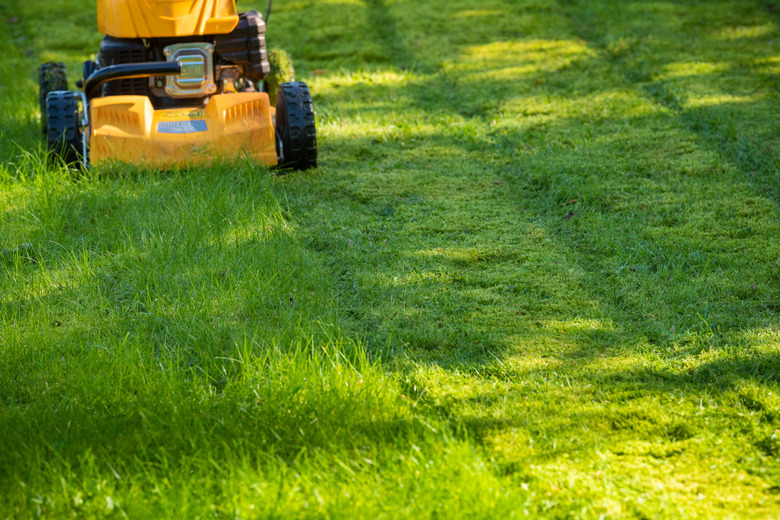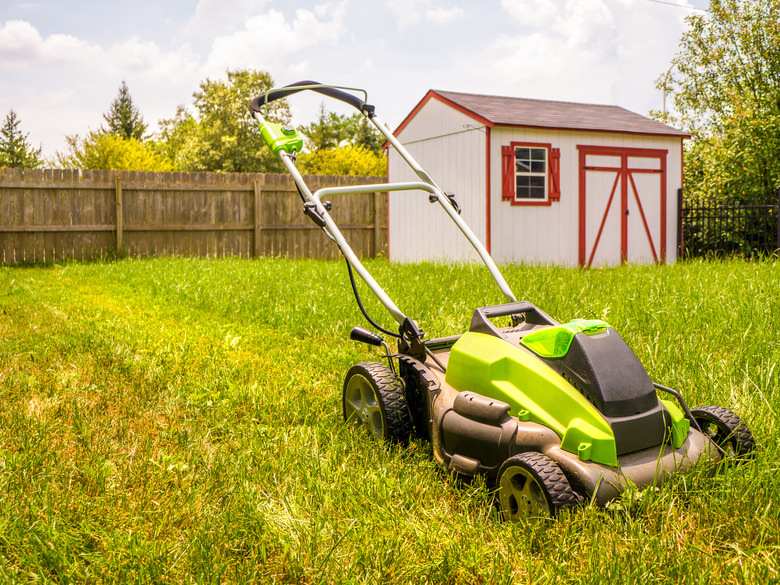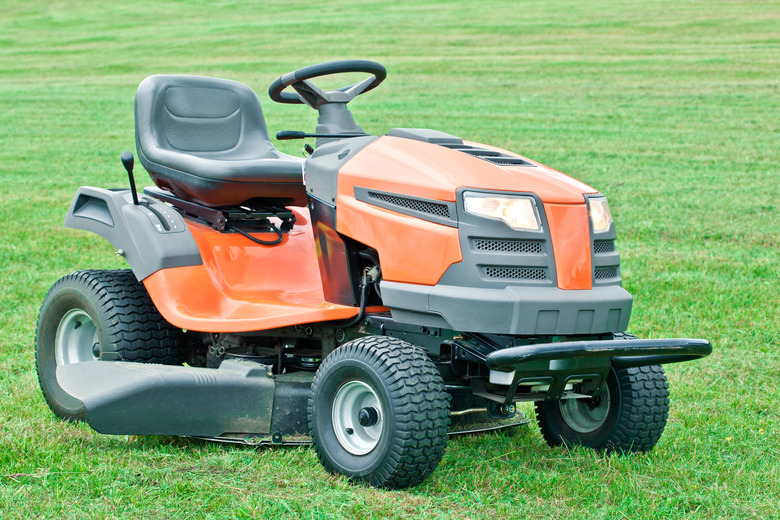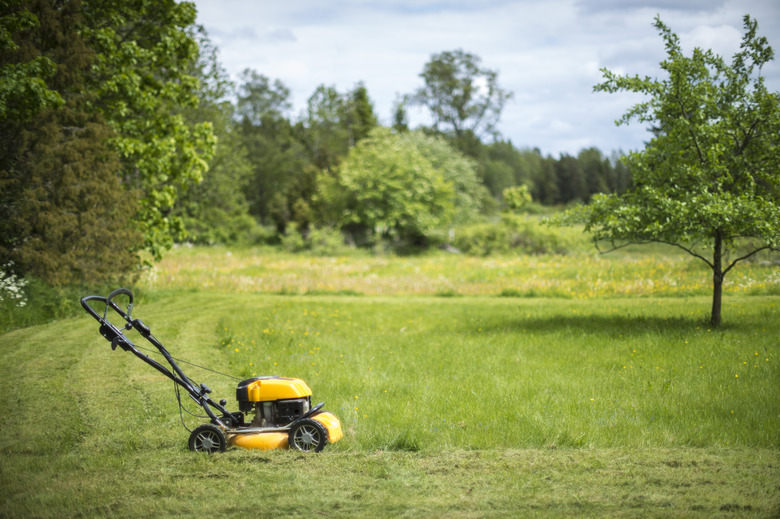How To Choose The Best Type Of Lawn Mower
We may receive a commission on purchases made from links.
Every lawn is different, so that new mower your next-door neighbor loves may or may not be a good fit for you. There are many different types of lawn mowers, and what you choose depends on your personal preferences as well as the specific traits of your lawn. While a riding mower is great for large areas, a basic reel mower or push mower may work best if you have a city home with a postage-stamp lawn. To keep from getting overwhelmed by all the choices, it's best to have a basic understanding of what you want before you go shopping.
Push Mower Overview
Push Mower Overview
If you have a small yard, a push mower may be all you need. Sometimes called reel mowers, push mowers have no engine. The blades simply turn as you push the mower from behind. Push mowers can save you money when you purchase them and keep doing so as you use them. You can get a push mower for less than $100, and you won't have to keep putting gas and oil into it.
Push mowers are much easier to maintain than other types of lawn mowers, and they're the ultimate in environmental friendliness. They also won't disturb the neighbors since they're very quiet. Keep in mind, however, that you'll need to stay on top of your lawn care chores if you opt for a reel mower. They simply can't handle very thick grass and tend to struggle with zoysia, St. Augustine and Bermudagrass.
Mowing with a push mower is also time-consuming. On average, it takes about 30 minutes longer to mow grass with a push mower than with a powered one. They're great if you want a low-maintenance, emissions-free option for a small lawn.
Just be sure to keep on top of the mowing. If you let the grass get too long, your reel mower won't cut it, and you'll have to hire a neighborhood kid or borrow a power mower to trim it to a cuttable length. Reel mowers are generally 14 to 20 inches wide.
Electric Lawn Mowers
Electric Lawn Mowers
Some electric lawn mowers are corded and plug into an electrical outlet. These units are still widely available, but they've fallen out of favor and for good reason — it's cumbersome to drag an electrical cord behind you as you mow, and your mower will stop running if you accidentally cut a power cord.
Even a long cord limits your mowing range by keeping you tethered to a wall. On the plus side, however, you won't run out of gas or electricity while you mow. The mower will keep running until you get the job done. Still, a corded electric mower is best reserved for very small lawns.
Lawn mowers with an electrical cord are small, with a 14-inch deck. This is usually more than adequate, however, since corded mowers are only useful for small lawns. Corded electric lawn mowers are often push mowers, but self-propelled units are available.
Battery-Powered Lawn Mowers
Battery-Powered Lawn Mowers
Quieter than gas mowers, battery-powered mowers draw their power from rechargeable lithium-ion batteries. You'll have to periodically sharpen the blade of a battery-powered mower and make sure your batteries are charged when you want to mow. Other than that, battery-powered lawn mowers are fairly maintenance-free.
Battery-powered units don't have exhaust and are more environmentally friendly than gas mowers, but because they usually get their energy from a power plant (unless you have solar power), they're not emissions-free like push mowers. Decks on battery-powered mowers typically range from 19 to 20 inches, but you can find a mower with a 21-inch deck if you're willing to do a little searching.
Unfortunately, batteries weaken and ultimately die as you use them. Most will run continuously for 35 to 40 minutes before needing a recharge. This is fine when you're mowing small lawns, but it's frustrating to run out of power halfway through a bigger job. If you're working with more than 1/3 of an acre, battery-powered lawn mowers may disappoint you.
You can, of course, purchase an extra battery for your mower and just change the batteries if you run out of juice partway through the lawn. Extra batteries can cost anywhere from $60 to $100.
Gas Lawn Mowers
Gas Lawn Mowers
Gas lawn mowers are extremely popular, and it's easy to see why homeowners like this type of lawn mower. They're relatively inexpensive and can handle even thick grasses and overgrown weeds. Like battery-powered units, some gas mowers are self-propelled, and others require that you push them across the yard. Gas engines will run until their tank is empty, at which time you can easily add more fuel and be on your way.
These combustion engines do need a little more care than some of their counterparts. In addition to sharpening the blade, you'll need to perform oil changes on your mower or make sure you add oil to your gas if you have a two-cycle engine. You'll also need to perform periodic spark plug and air filter changes just as you do on your car. Another con is that gas lawn mowers are loud and produce a significant amount of emissions that aren't good for the environment.
Gas mowers work best in areas that are about 1/4 to 1/2 acre in size, and they have a 21- or 22-inch mower deck. They're also helpful if you have a lot of obstacles in your lawn around which you must mow. Small gas mowers can get into tight spaces where a riding mower can't.
Riding Lawn Mowers
Riding Lawn Mowers
If you have a big mowing job ahead of you, it makes sense to tackle it with some bigger equipment. Sometimes called lawn tractors, riding mowers allow you to sit comfortably on top of the mower and drive it across your lawn. Riding mowers are excellent when you have a big lawn that's fairly smooth and even.
As an added bonus, many lawn tractors allow you to mount a plow to the front of the mower or drag behind tilling, seeding and other equipment. This feature gives you more bang for your buck. Lawn tractors can be pricey, but you can use them in many more ways than you can a push mower.
Riding mowers run on gasoline and need regular oil changes and blade sharpening. Like their smaller gas counterparts, they also need an occasional tune-up and air filter change. These large mowers can prove to be harder with which to work, however, and you may feel safer taking yours to a professional for service rather than trying to sharpen the blade yourself.
Note too that riding mowers don't work well on hilly terrain and are unsafe on steep hills. You also won't be able to get too close to trees, planting beds and other landscape features around which you need to mow. Riding mowers are best for large, open areas, and they can cut 42 to 48 inches across. Before buying a large lawn tractor, make sure you have ample shed or garage space for storage.
Rear-Engine Riding Mowers
Rear-Engine Riding Mowers
Most riding lawn mowers look like little tractors with the engine sitting out in front. Rear-engine mowers, however, house their engines in the back of the mower. These units cost less than more traditional riding mowers, but they're not as wide, so you'll need to make a few more passes across the lawn to get all the grass cut. Like lawn tractors, this type of lawn mower uses a gasoline engine that needs fuel and occasional maintenance.
Rear-engine riding mowers are more compact than lawn tractors, however, which is a plus if you have limited storage space. The downside is that the decks on the rear-engine riding mowers are only about 30 inches wide. Many will give you a much rougher ride than you would get on a lawn tractor, and many homeowners also feel that rear-engine mowers don't cut the grass as well.
Zero-Turn Mowers
Zero-Turn Mowers
Zero-turn mowers are about the most fun you can have when mowing your lawn. You stand or sit on a zero-turn mower just as you do a lawn tractor. Zero-turn mowers have a much smaller turning radius, however, and can travel at faster speeds. These mowers make it easy to zip back and forth across the lawn while getting closer to flower beds and other mowing obstacles.
Zero-turn mowers are expensive, however, and they're not safe to use on hilly terrain. They also usually have steering levers rather than a steering wheel, and getting used to maneuvering them can be tricky and can take a little practice. Because they move so fast, some don't cut the grass as well as a riding mower would. To get a good cut, you may have to decrease your mowing speed, negating the benefit of a faster mower.
Like lawn tractors, zero-turn mowers run on gas and need occasional maintenance. These mowers are used by professional landscapers and are rarely used by homeowners. They'll make quick work of a large lawn, however, with a mower deck of 42 to 50 inches wide.
Other Lawn Mower Considerations
Other Lawn Mower Considerations
Once you've decided what type of mower works for you, there are a few other options worth considering. When looking at a self-propelled mower, for instance, take note of whether the mower is front-wheel or rear-wheel drive. Front-wheel drive is best for mowing around obstacles since you can simply lift the front wheels off the ground if necessary to change direction. Rear-wheel drive provides better traction on hills and inclines.
Some self-propelled mowers come with only a slow and fast speed option when you really want something in the middle. You can work around this by choosing a variable-speed mower. These mowers adjust their speed based on how firmly you squeeze the handle, operating much like the gas pedal in your car. This provides much more control over your mowing speed.
Some riding mowers have a usage meter that logs how many hours of mowing you've done. This is handy, as it lets you know exactly when your mower is due for an oil change or fresh spark plugs. You can also look for a mower with a hose attachment. This allows you to easily attach your garden hose to the mower so you can flush it out with water to clean the bottom of the mower deck.
Most lawn mowers give you the option of bagging your lawn clippings or discharging them onto the lawn. If you like bagging your grass, look for a mower with a bag small enough to handle easily but large enough that you won't feel as though you're constantly emptying it. Some mowers even have an option for mulching your grass cuttings, making them extra fine and eliminating the need to bag the grass.



